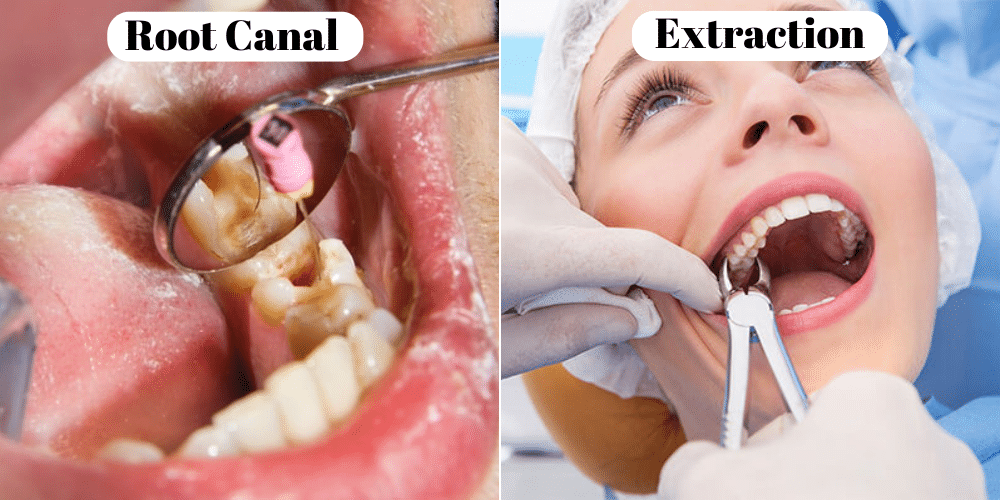Toothaches are no fun. They can disrupt your sleep, make eating a chore, and leave you feeling grumpy. If you’re facing a dental crisis, you might be wondering: root canal or extraction? Both procedures address a damaged or infected tooth, but they take different approaches. Let’s dive into the world of root canals and extractions to help you choose the path to a pain-free smile.
Understanding the Battlefield: Inside Your Tooth
Before we explore the combatants (root canal vs. extraction), let’s understand the battleground: your tooth. A tooth has several layers. The hard outer shell is enamel, protecting the softer dentin beneath. Inside the dentin lies the pulp, a soft tissue containing nerves, blood vessels, and connective tissue. The pulp keeps your tooth alive and helps it sense temperature and pressure. Now, imagine bacteria sneaking past the enamel and dentin, reaching the pulp. This infection or inflammation is the culprit behind your throbbing woes.
Enter the Contenders: Root Canal vs. Extraction
Champion #1: The Root Canal
A root canal is a superhero when it comes to saving your natural tooth. Here’s how it works:
- Anesthesia: Your dentist numbs the area around the tooth to ensure a comfortable experience.
- Access: A tiny opening is made in the crown (top) of your tooth to reach the pulp.
- Pulp Removal: The dentist removes the infected pulp, including nerves and blood vessels.
- Cleaning and Disinfection: The canals (tiny passageways) within the root are meticulously cleaned and disinfected to eliminate any remaining bacteria.
- Filling and Sealing: The canals are filled with a special material to prevent reinfection.
- Restoration: In most cases, a crown is placed on the tooth to restore its strength and appearance.
Benefits of a Root Canal
- Saves Your Natural Tooth: This is the biggest advantage. Natural teeth provide the best chewing function and contribute to a healthy jawbone.
- Preserve Facial Structure: Missing teeth can cause facial sagging. Root canals prevent this.
- Cost-Effective in the Long Run: Though more expensive upfront than an extraction, a root canal saves you money compared to replacing a tooth with a bridge or implant.
Challenger #2: Tooth Extraction
A tooth extraction involves the complete removal of the tooth, including its root. It’s a quick and effective solution but with some drawbacks. Here’s the tooth extraction procedure:
- Anesthesia: Similar to a root canal, the area will be numbed.
- Tooth Loosening: Your dentist loosens the tooth with special instruments.
- Tooth Removal: The tooth is gently extracted from its socket.
- Cleaning and Stitching: The extraction site is cleaned, and stitches might be placed to help healing.
When Extraction Might Be Necessary
- Severely Damaged Tooth: If a crack extends below the gum line or a large portion of the tooth is broken, extraction might be the only option.
- Advanced Infection: In some cases, the infection is too severe for a root canal to be successful.
- Impacted Tooth: A wisdom tooth that’s stuck or causing problems might need extraction.
Choosing Your Champion: Factors to Consider
Having a damaged or infected tooth can be a source of pain and worry. After reviewing both root canals and extractions, here’s a breakdown of key factors to consider when deciding on the best course of treatment for you:
Severity of the Damage
This is a major deciding factor. Root canals are generally preferred for teeth with moderate decay, cracks that don’t extend below the gum line or infected pulp. If the damage is severe, like extensive decay or infection, an extraction might be necessary.
Location of the Tooth
Generally, dentists prioritize saving front teeth due to their significant role in aesthetics and speech. Root canals are often recommended for these teeth whenever possible. However, when molars take more precedence over appearance, an extraction might be a viable option, depending on the severity of the damage.
Overall Health
Certain medical conditions, like a weakened immune system or uncontrolled chronic diseases, could influence your dentist’s recommendation. In some cases, a root canal might be contraindicated due to potential risks associated with the procedure. Your dentist will consider your medical history to ensure the safest and most suitable treatment plan.
Cost Comparison
While extractions tend to be less expensive upfront, it’s important to consider the long-term costs. A missing tooth can affect your ability to chew properly and can lead to jawbone deterioration over time. Replacing a missing tooth with options like implants or bridges can be significantly more expensive than a root canal.
There’s no one-size-fits-all answer to the root canal vs. extraction debate. The best course of action depends on your specific situation. Here’s the key takeaway: consult with your dentist. They will conduct a thorough examination, discuss your X-rays, and explain your options in detail. With clear information and open communication, you and your dentist can choose the champion.




